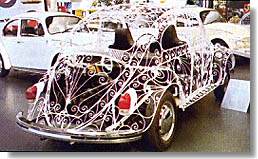
|
Wrought
Iron Beetle
This
particular Beetle is on display at the VW museum. The history regarding
this exhibit is not available. However, a similar car appeared in
a film starring Bud Spencer. We do not know whether this is one and
the same car. |
| Beetle
Train
This
particular Beetle was constructed by the factory to ferry visitors around
the plant. The vehicle has now been decommissioned and is on exhibition
at the VW Museum. |

|
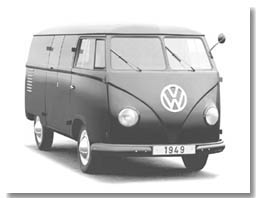
|
1949
Type 2 Van
Nothing
extraordinary about this split screen van, except for the 1949 number plate.
As the VW Type 2 was released in 1950, this must either be a prototype/pre-production
example or one of the vans that were actually built between November and
December 1949 when production first got under way. |
| Off-Road
Study
Known
as the Advanced Activity Concept (AAC), it combines the functions of a
pick-up with the luxury of a top-class sedan. With four-wheel drive,
and powered by a 230 kW (313 hp) V10 TDI diesel engine, the AAC’s front-end
styling echoes the Concept D car. A six-speed automatic transmission
with Tiptronic manual shift mode transmits engine power to a permanent
four-wheel drive system. |
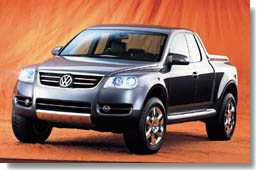
|
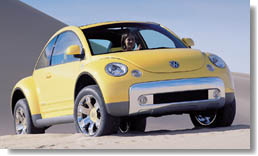
|
New
Beetle Dune
A New
Beetle study aimed directly at the needs of sports-oriented people.
Powered by a 2.3-liter V5 engine and drives all four wheels by VW's 4Motion
system, through a six-speed manual-shift gearbox, the New Beetle Dune will
take you on after the road has come to an end. Variable-height air suspension
can match the ride height to all kinds of terrain. |
| W12
Concept
This
sleek exotic GT made its debut at the 1997 Tokyo Motor Show. The W12 is
a carbon-fibre concept that was conceived to house VW's newest innovation:
a 5.6-liter "W12" engine. The 12-cylinder engine is basically two narrow-angle
VR6 engines sharing a common crankshaft. |
 |
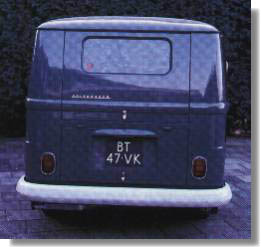
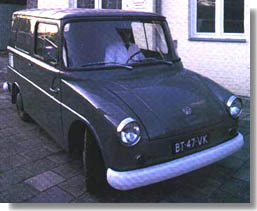
|
Volkswagen
Typ 147 Fridolin
Most
Volkswagen fans have probably never heard of this car. It's official name,
'typ 147 Sonderfahrzeug Post' indicates it's origin. The German National
Postal Services (Deutsche Bundespost) was looking for a reliable, cheap,
maintenance-friendly, ergonomical truck. So the aforementioned Bundespost
sat around the table with Volkswagen and Westfalia and this is what came
out. Why the 'Fridolin'? As the legend goes, when it first was presented
one of the Westfalia employees said: "Hey, it looks a little like Fridolin!"
According to the legend Fridolin was a fellow-employee at Westfalia.
At
the time it was probably a joke, but fact is that this car is still being
referred to as Fridolin by experts. Early 1964 Volkswagen presented the
early prototypes of the typ 147, shortly thereafter production began. It
was produced until 1973. Around 6000 Fridolins were built. Most of the
cars went to the German and Swiss Postal Services but they were also available
for private buyers. Technically the tpy 147 is a mixture of different VW's.
It was built on a Karmann Ghia chassis with a Beetle engine and it had
Bus taillights. Though it's hard to find a Fridolin today, the German Postal
Services still sell model cars of the Fridolin, they must have liked it
a lot. |
The
Jetta Convertible
January
1977, VW engineers started thinking of a convertible car. By this time
the Jetta I wasn't even born yet. It was in progress to, under the codename
"Hummel" or "EA165" as a sedan version of the popular Golf models. VW engineers
were in doubt whether to produce a convertible version of either the Golf
or the Jetta. They decided in favor of the Golf and from early 1979 it
was available as a cabriolet. The Jetta sedan went into production six
months later. Some time after the Jetta went into production the German
newspaper "Die Welt" speculated on a cabriolet version of the newly introduced
Jetta. For this they manipulated a series of photo's thus coming up with
a convertible car.
This
stimulated Volkswagen's design department in Osnabrueck. They decided to
build a Jetta cabriolet for real. They started by acquiring a two-door
version of the Jetta. For starters the roof was cut off. A lot of reinforcement
had to be done to compensate the loss of stiffness. All they basically
did was transplant a whole lot of Golf I parts to the topless Jetta. The
rollbar just had to be welded in place. Frameless Golf doors replaced the
Jetta ones and parts of Golf I cabriolet fenders were used to construct
new rear fenders for the Jetta. The Golf roof could now be placed on the
Jetta and there it was, a Jetta convertible. |
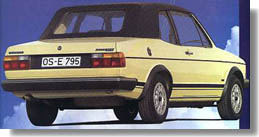
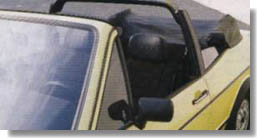
|
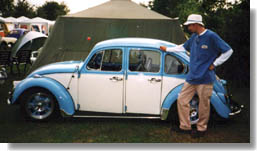
|
4
Door Beetle
This
interesting photograph was taken by our man at VW Euro in summer '99.
No information is available about this Beetle. Although some 4 door
models were produced for the German Police, this car seems to be a conversion,
because of the ventilator behind the rear quarter window. |
| VW
Type 2 Ambulance
The
Type 2 was extensively used as an ambulance throughout the world.
The interesting part of this particular example, again photographed at
VW Euro '99, is the Maltese cross on the front and side panels. It
belongs to the Malteser Hilfsdienst e.V. Their logo is a white Maltese
Cross (usually with the letters MHD above it) on a red background.
This is a voluntary youth organization, which is heavily sponsored by the
German state. Their work is to patrol, execute rescue work, and administer
First Aid in specific areas allotted to them by the German Government.
Such areas include motorways, highways and rough terrain. In return,
the government provides them with ambulances, rescue trucks and even helicopters
to patrol the roads and countryside. The organization is completely
run by volunteers over 16 years of age. |
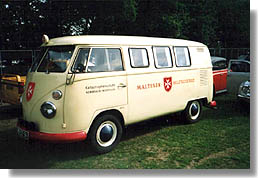
|
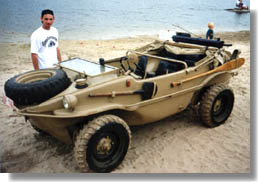
|
VW
Schwimmwagen
This
Schwimmwagen was again photographed at VW Euro in summer '99. No
information about this particular amphibian is available, although enthusiasts
will know that the type was produced for the German Army during the Second
World War and could, as its name implies, take to the water. |
| VW
Beetle Afloat
An
unusual photograph of a Beetle at sea, to compliment our previous shot
of the Schwimmwagen. The Beetle was never intended to take to the
water, although this particular example obviously has. The particular
circumstances leading to this event are not known. |
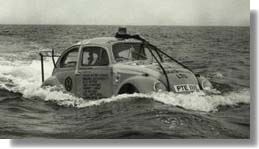
|
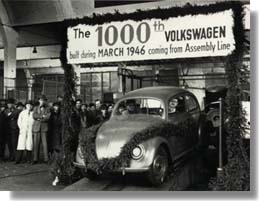
|
VW
Beetle Milestones - 1,000th Car
The
1,000th Beetle rolls off the assembly lines in March 1946. This is
the first of a series of VW production milestone photographs we are reproducing
here. The factory encountered severe supply problems at this time,
including sheet metal, carburators and headlamps. This is evident
in our photo, as this Beetle is equipped with Kubelwagen headlamps. |
| VW
Beetle Milestones - 10,000th Car
This
Beetle, the 10,000th car, was produced in October 1946. At the time,
production of an order for 20,000 cars for the British army was still under
way. Food for the work force was still scarce, as clearly shown by
the various placards placed around the car. |
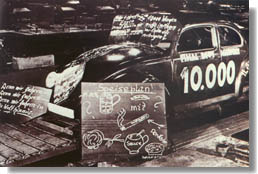
|
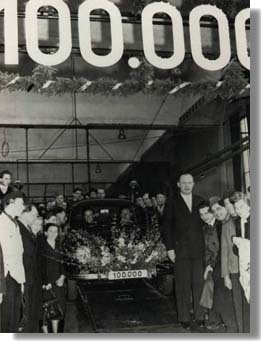
|
VW
Beetle Milestones - 100,000th Car
Supply
difficulties had, by now been ironed out, as this photo illustrates.
Little else is known except that VW deemed this to be another important
achievement in its history. |
| VW
Beetle Milestones - 15 Millionth Car
This
photo was meant to document the event that made the Beetle the most produced
car since the Ford Model T. Subsequently, Ford is said to have discovered
some unaccounted for production figures which, once again, were surpassed
by the Beetle, making it the most produced car in history. |
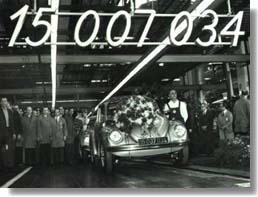
|
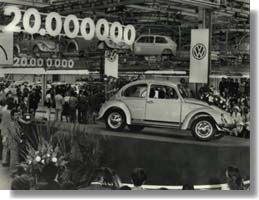
|
VW
Beetle Milestones - 20 Millionth Car
Another
milestone in Beetle production history was the 20 Millionth car produced.
Production has gone on and the total number of cars produced is now well
over this figure and still rising at the time of writing. |

